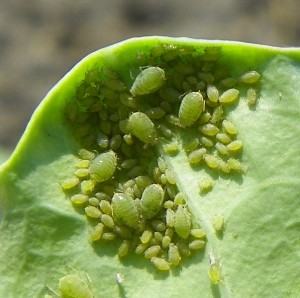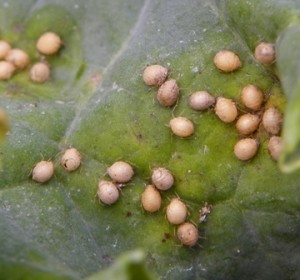How to Control Aphids in Vegetable Crops
go.ncsu.edu/readext?186290
en Español / em Português
El inglés es el idioma de control de esta página. En la medida en que haya algún conflicto entre la traducción al inglés y la traducción, el inglés prevalece.
Al hacer clic en el enlace de traducción se activa un servicio de traducción gratuito para convertir la página al español. Al igual que con cualquier traducción por Internet, la conversión no es sensible al contexto y puede que no traduzca el texto en su significado original. NC State Extension no garantiza la exactitud del texto traducido. Por favor, tenga en cuenta que algunas aplicaciones y/o servicios pueden no funcionar como se espera cuando se traducen.
Português
Inglês é o idioma de controle desta página. Na medida que haja algum conflito entre o texto original em Inglês e a tradução, o Inglês prevalece.
Ao clicar no link de tradução, um serviço gratuito de tradução será ativado para converter a página para o Português. Como em qualquer tradução pela internet, a conversão não é sensivel ao contexto e pode não ocorrer a tradução para o significado orginal. O serviço de Extensão da Carolina do Norte (NC State Extension) não garante a exatidão do texto traduzido. Por favor, observe que algumas funções ou serviços podem não funcionar como esperado após a tradução.
English
English is the controlling language of this page. To the extent there is any conflict between the English text and the translation, English controls.
Clicking on the translation link activates a free translation service to convert the page to Spanish. As with any Internet translation, the conversion is not context-sensitive and may not translate the text to its original meaning. NC State Extension does not guarantee the accuracy of the translated text. Please note that some applications and/or services may not function as expected when translated.
Collapse ▲When planted in late summer, cool season crops like cabbage, collards, broccoli, kale, and turnips usually thrive with minimal care. One pest that can cause problems for these crops that has shown up in our area this fall is the aphid. Though individually tiny, aphids frequently occur in huge numbers and can cause serious problems for vegetable crops. Aphids are easy to manage with either organic or synthetic insecticides, if they are detected before numbers get out of hand.
All about Aphids
Aphids are tiny (1/8”), oval to pear-shaped, soft bodied insects, sometimes referred to as plant lice. They occur in a variety of colors, including green, yellow, orange, brown, and black. Like all insects, aphids have six legs. One thing that sets them apart from other insects is a pair of cornicles on their rear end which look like two exhaust pipes. Another unique feature of aphids is that they rarely lay eggs, and instead give birth to live young, which are clones of their mother. This ability results in rapid, explosive increases in aphid numbers in a very short time.
All aphids are sap feeders, meaning they feed on plant sap with their needle like mouthparts rather than eating leaf tissue. There are many species of aphids, most of which feed on specific plants. For example, crape myrtle aphids will only feed on crape myrtle and are not a threat to any other plants in the landscape or garden. The two most common aphids that cause problems in vegetable gardens at this time of the year are the cabbage aphid and the turnip aphid. These two aphids are extremely similar in appearance. Both are green in color and feed on plants in the crucifer family, such as cabbage, collards, kale, turnips, mustard, broccoli, cauliflower, brussel sprouts and radish.
Detecting Aphid Activity
Cabbage and turnip aphids are most prevalent in cool dry weather. Because they feed on plant sap from the underside of leaves, they are often not noticed until their numbers become severe. Aphid feeding can cause plants to produce crinkled, cupped or deformed leaves. Feeding by large populations will stunt plants and can kill small plants. Aphids also excrete honeydew, a sticky, sweet, clear substance that can coat plant leaves and attract ants and wasps. Gardeners should inspect the backside of plant leaves, particularly tender new leaves, for aphids each week.
If you find aphids in your garden, keep a look out for “aphid mummies”. These are the bodies of aphids that have been parasitized by a species of very small wasp that do not sting people. These are a good sign that mother nature is helping defend your garden! “Aphid mummies”, are bronze or tan in color and appear ‘puffed up’ when compared to living aphids.
Controlling Aphids
Because aphids can reproduce extremely rapidly, they should be controlled as soon as they are found. Cabbage and turnip aphid are not killed by cold weather in our area and survive through the winter, most commonly on collards. If you only find a few aphids, squish them or break off infested leaves and remove them from the garden. Both organic and synthetic insecticide sprays are available to control aphids in the vegetable garden. When using either, make sure to cover plants completely, especially the backside of leaves, since aphids often shelter in pockets and crevices underneath leaves and in buds. Repeated applications are usually necessary to control this pest.
Organic insecticides that are effective for aphid control in vegetable gardens are insecticidal soap, pyrethrin, and neem oil. For these products, vegetables can be harvested from treated crops the same day of application. Aphids also have many natural enemies, including ladybugs, parasitic wasps, and hoverfly larvae. In landscape plants, natural enemies can often be relied upon to clean up aphid infestations. In vegetable gardens though, aphid outbreaks usually cause lasting damage before natural enemies are able to reduce their levels.
Synthetic insecticides for aphid control on vegetables include those containing the active ingredients permethrin or bifenthrin. Both of these products are available under several name brands, so check product labels to find these in local garden centers. Permethrin has a one day post harvest interval, meaning you have to wait at least one day after treating to harvest. For bifenthrin, the post harvest interval is seven days.
Aphids can be washed off of harvested leaves with running water or by submerging harvested crops in soapy water and then rinsing with clean water. Vegetables that aphids have fed upon are safe to eat and if you don’t get every single aphid off don’t worry — they will just add a little protein to your meal!
Learn More
Learn more about aphids and other common pests of fall crops from this Clemson Extension fact sheet: http://www.clemson.edu/extension/hgic/pests/plant_pests/veg_fruit/hgic2203.html
Visit your local Cooperative Extension office to learn more about gardening and landscape care. Go to https://www.ces.ncsu.edu/local-county-center/ to find your county Extension center.
- If you live in Pender County, call 910-259-1235
- In New Hanover County, call 910-798-7660
- In Brunswick County, call 910-253-2610
- In Onslow County, call 910-455-5873
- In Duplin County, call 910-296-2143





